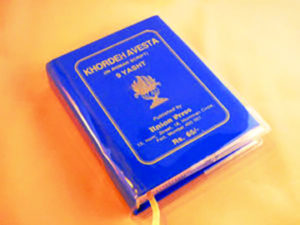 Sunday, 17th September, 2023, will be observed as the Parab of Ardibehesht. Ardibehesht – the second month of the Zoroastrian calendar – celebrates Divine Truth, Righteous or Divine Order and Healing.
Sunday, 17th September, 2023, will be observed as the Parab of Ardibehesht. Ardibehesht – the second month of the Zoroastrian calendar – celebrates Divine Truth, Righteous or Divine Order and Healing.
Ardibehesht is an Amshaspand (Archangel) or Amesha Spenta (Bounteous Immortal) that presides over the energy of fire. Adar Yazad is a Hamkara or helper of Ardibehesht. This is why many fire temples were consecrated in this month – the most notable being the Anjuman Atash Behram, consecrated on Roj Ardibehesht of Mah Ardibehesht (1897) and the Navsari Atash Behram, consecrated on Roj Sarosh of Mah Ardibehesht (1765).
In the Avesta, Ardibehesht is referred to as Asha Vahishta. Asha is variously translated as Truth, Righteousness and Divine Order. Vahishta mean ‘the Best.’ Ardibehesht embodies Ahura Mazda’s Truth and Righteousness or the Divine Order, with which Ahura Mazda created and sustains the Universe. Divine Order is the law under which the entire cosmos operates. It is every Zoroastrian’s duty to live his or her life in harmony with this order or law.
The Truth… is about honesty and integrity. These two terms seem synonymous. However, while honesty is about truthfulness, integrity is about adherence to moral and ethical principles. Honesty simply means telling the truth, while integrity means doing the right thing, immaterial of all else. While one can be honest without having integrity, one cannot have integrity without honesty. Honesty is doing the right thing in front of others. Integrity is doing the right thing even when others are not watching. Thus, honesty is a value while integrity is a way of life.
Ardibehesht is the embodiment of Divine Truth, and in the Zoroastrian religion, truth is considered as the highest virtue. In fact, Rasti (truth) and Radhi (charity) go hand in hand. It is only through truth and righteousness that Ahura Mazda’s friendship can be attained.
In the Hoshbam prayer, usually recited at dawn, we chant, “Asha vahishta, asha sraeshta, daresāma thwā, pairi thwā jamyāma, hamem thwā hakhma,” which means, “Through the best righteousness, excellent righteousness, O Ahura Mazda, may we catch sight of Thee and may we come near Thee and attain Thy eternal friendship.”
Righteous Living… As per Zoroastrianism, life should be lived walking on the path of Asha – truthfully and with righteous conduct. To do so is to live a principled life. It means to always be truthful, practice compassion towards all, to perform one’s duties at all times, to develop a keen sense of right and wrong, and do what is right. It means recognizing one’s inner weaknesses and negative traits, and then overcoming them.
It means to be true to what one believes is right, even if others do not agree. It means realising one’s purpose on earth and fulfilling that purpose. It means contributing positively to this world and to its progress, and protecting the earth. A righteous life is a difficult life, but it is the only true way.
In ancient times, whenever Zoroastrians built or acquired new homes, they would arrange for a prayer room or a prayer corner to be prepared and before occupying the house, would arrange for fire or Ardibehesht to be brought home. The entire family would pray before this fire day and night. Bringing Ardibehesht home symbolically meant bringing home truth, righteousness, and divine order.
Even today, when we light a diva (oil lamp) at home we should visualize ushering the energies of truth and righteousness in our lives and divine order in our homes. Above all else, Ardibehesht is a healing and life-giving force. Hence, keeping a fire at home, even if just an oil lamp means keeping the energy of life and good health flowing at home.
Ardibehesht Yasht – A Healing Prayer: The Ardibehesht Yasht is one of the best prayers for healing all kinds of physical ailments. There is also an old healing tradition of ‘Ardibehesht ni Picchi’, where a priest or even a lay person, after a bath and performing the farazyat (obligatory) prayers, recites the Ardibehesht Yasht, running a clean white handkerchief or a clean muslin cloth from head to toe of the ailing person. It is a tried and tested Zoroastrian form of healing, with a high degree of success.
In the Ardibehesht Yasht we pray, “Ādim framraomi Ashem Vahishtem; yezī framraomi Ashem Vahishtem, āat anyaēsham Ameshanām Spentanām hvāyaonem; yim pāiti Mazdāo humatāish, yim pāiti Mazdāo hūkhtāish, yim pāiti Mazdāo hvarshtāish. Garō-nmānem Ahurahe hvāyaonem. Garō-nmānem nereyō asti ashāvaoyō. Naēchish dravatām ayene paitish garō-nmanem, ravohu ashāyonem chithrem Ahurem Mazdām.”
Translation: “I like Him (Ardibehesht); when I like Ardibehesht, then (He) of (all) other Ameshāspands (becomes) a helper, whom (the Creator) Ahura Mazda nourishes with good thoughts, and good words, and good actions. The Garothmān (Paradise) is Ahura Mazda’s own abode. The Garothmān (Paradise) is for righteous persons.” The essence of this verse is that only a righteous person can be in the abode or presence of Ahura Mazda.
The Ardibehesht Yasht also refers to five types of healers: “Ashō-baēshazō, dātō-baeshazō, karetō-baēshazō, urvarōbaēshazō, mānthrō-baēshazō; baēshazanām baēshazyōtemō yat mānthrem-spentem-baēshazyō; yō narsh ashaonō hacha uruthwān baēshzyāt, aeshō zī asti baēshazanām baēshazyōtemō” or “One who heals by means of purification rites or through his own Ashoi or piety (Ashō-baēshazō); One who cures (social ills) by law and justice (dātō-baeshazō); One who heals with the knife like a surgeon (karetō-baēshazō); One who restores health by means of herbs and vegetation (urvarōbaēshazō); and One who heals by means of reciting the mānthra or prayers (mānthrō-baēshazō)”. The Yasht affirms: “best among healers is the one who heals reciting the mānthra.”
The Nirang Of Ardibehesht: The Nirang of Ardibehesht is a very powerful capsule prayer which should be recited three times after the recitation of Ardibehesht Yasht. “Dādāre jehādār tavānā O dānā, O parvartār O āfarīdegār, O kerfehgar, O avakhshīdār. Ahereman hīch, nādān, O natavānad ba hīch chīz nashahed. Ahura Mazda dādārī, ahereman marochīnīdārī. Dādār pāk, ahereman nāpāk; ahereman khāk shavad, ahereman dūr shavad, ahereman dafe shavad, ahereman shekasteh shavad, ahereman halāk shavad. Avval dīn Zarathushtī pāk; Ahura Mazda buland kavī, beh, awazūnī.” Which means, “The Creator, the keeper of the world, (is) omnipotent and omniscient, and the Nourisher of all, and the producer, and the Doer of meritorious deeds and overseer. Ahriman is nothing whatsoever (and is) ignorant, and cannot do anything. Hormazd (is) the Creator (and) Ahriman the destroyer. The Creator (is) Holy and Ahriman (is) wicked. May Ahriman perish, may Ahriman be far away, may Ahriman be vanished, may Ahriman be defeated and may Ahriman be overcome. The foremost Religion (is the) pure Zoroastrian (Religion); Hormazd (is) Exalted, Powerful, Good (and) the Increaser.”
Airyaman Isho: The Ardibehesht Yasht also refers to the prayer of Airyaman Isho, which is actually Yasna 54. It is very efficacious and powerful should be prayed just before the chanting of Ardibehest Yasht. Airyaman Yazad is a co-worker of Ardibehesht Ameshaspand and therefore, it is considered very meritorious and beneficial to recite this manthra before the Ardibehesht Yasht. Yasna 54.1 is recited 4 times. It has the power to drive away diseases, physical, mental as well as spiritual. Part of it is composed in the Gathic dialect and it is affirmed that this specific Yasna 54 will be recited at the time of the future restoration of the world.
- In Search Of The Soul - 5 April2025
- Why Pray In A Language We Do Not Understand? - 29 March2025
- Celebrate Nature’s New Year With Purity And Piety of Ava - 22 March2025
